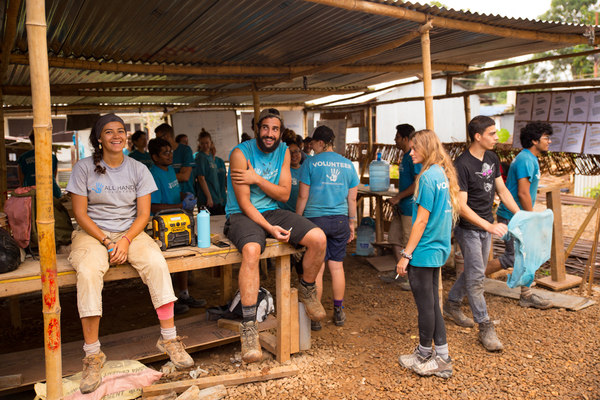Volunteers exposed to same hazards, perform similar work as paid staff but not usually covered by workers’ compensation

In July of 2017, John Howlett, a dedicated volunteer climbed aboard a government funded fishing vessel to rescue yet another whale caught up in fishing gear of the coast of New Brunswick. It was a task he had done many times before, and one his dedication and commitment would have seen him do many more times were it not for the incident that took his life on that fateful day. Because Howlett was not being paid for his work and not an employee, WorkSafeNB concluded that this was “not a workplace fatality” and abandoned its investigation into the incident.
Clocking in more than 2 billion hours of work annually, volunteers are one of the largest workforces in Canada. Averaging 156 hours of work each year and the equivalent of 1.1 million full-time jobs, this workforce is also among those exposed to some of the highest risks with the least amount of protections in place. Volunteers are exposed to the same hazards and risks and perform much of the same work as paid staff yet, in most provinces, they are not covered by workers’ compensation, instead depending on general liability policies and the fact that the organization is not-for-profit. This is further complicated by the fact that many not-for-profit organizations do not apply the same health and safety standards to the training and orientation of volunteers that they are required to provide to staff.
A 2016 report by Public Services Canada identified some significant deficiencies in coverage for volunteers in emergency management including search and rescue and emergency services during natural disasters. Not only are these volunteers not covered consistently by provincial and territorial workers’ compensation programs, but private insurance policies also fail to provide the coverage needed to provide adequate protection. These deficiencies are resulting in volunteers not being properly compensated when incidents do occur and a reduced number of individuals willing to volunteer.
Emergency services is only a microcosm of volunteering at large. Inconsistent coverage by provincial and territorial workers’ compensation programs, gaps in private insurance, and exposure to risks and hazards that, in some cases, are greater than those faced by volunteers in emergency services is just a part of the problem. The limited resources most not-for-profits have to commit to health and safety and the desire for volunteers to just get in and get their hands dirty without having to go through a lot of preliminary training only exacerbate these challenges. These factors combined with increasing injury litigation and the resulting financial rewards can have major ramifications for volunteers, not-for-profit organizations and the people that are benefiting from the programs.
Volunteer firefighters are recognized by most workers’ compensation programs in Canada but only a couple provinces will support other volunteers. That volunteer coverage is not automatic and requires an organization to apply for coverage for its volunteers. Many not-for-profit organizations are reluctant to do this because there is a cost associated with including volunteers in their workers’ compensation board coverage. Choosing not to include their volunteers under their WCB coverage is a risk analysis that each of these organizations needs to carefully consider along with the coverage their insurance policy provides.
Having the financial protections in place to support volunteers if an incident does occur is only a small part of the solution. The challenge facing not-for-profits is taking the appropriate steps in preventing incidents and protecting clients before an incident occurs. While this may sound simple in theory, these organizations often have limited resources, most of which their donors and supporters expect will be directed at the program and more specifically, the people the program supports. They are also faced with increased pressures on the time volunteers have available to commit to their causes. A Charity Village article quotes one non-profit network executive describing the risk management process as becoming “lengthy and onerous.” Using the limited and valuable time of a volunteer to provide training on health and safety policies and procedures can result in these volunteers committing their time elsewhere.
So how does a not-for-profit organization ensure the health and safety of its volunteers? By taking the same approach it should be taking with its employees.
•Define their roles. This task can be challenging as volunteers often step in to a variety of roles as needed or at the last minute.
•Identify risks and hazards. It is important to remember that volunteers are subject to the same hazards and risks that staff in the same role would encounter, including mental health risks. They may even be at increased risks when it comes to psychological safety as they don’t have the same training and educational background that staff have had to prepare them for adverse situations.
•Inform the volunteers. This may send some volunteers running in the other direction but there is a duty for organizations to inform staff and volunteers of the hazards and risks they are exposed to. Failure to communicate this information to the volunteers puts the burden of the liability on the organization and the officers of that organization.
•Ensure controls are put in place. Training takes time and manpower, both of which are at a premium in organizations that depend on volunteer support. Going through this job hazard assessment process lets you prioritize the training and provide the training specific to that role rather than insisting all volunteers go through everything. Done well it can help to engage volunteers in the organizations mission and goals, ultimately leading to increased volunteer retention and reducing the costs of constantly training new volunteers.
Without the commitment and support of the volunteers supporting not-for-profits our society would be much different. Organizations need to return that commitment and support to their volunteers.






